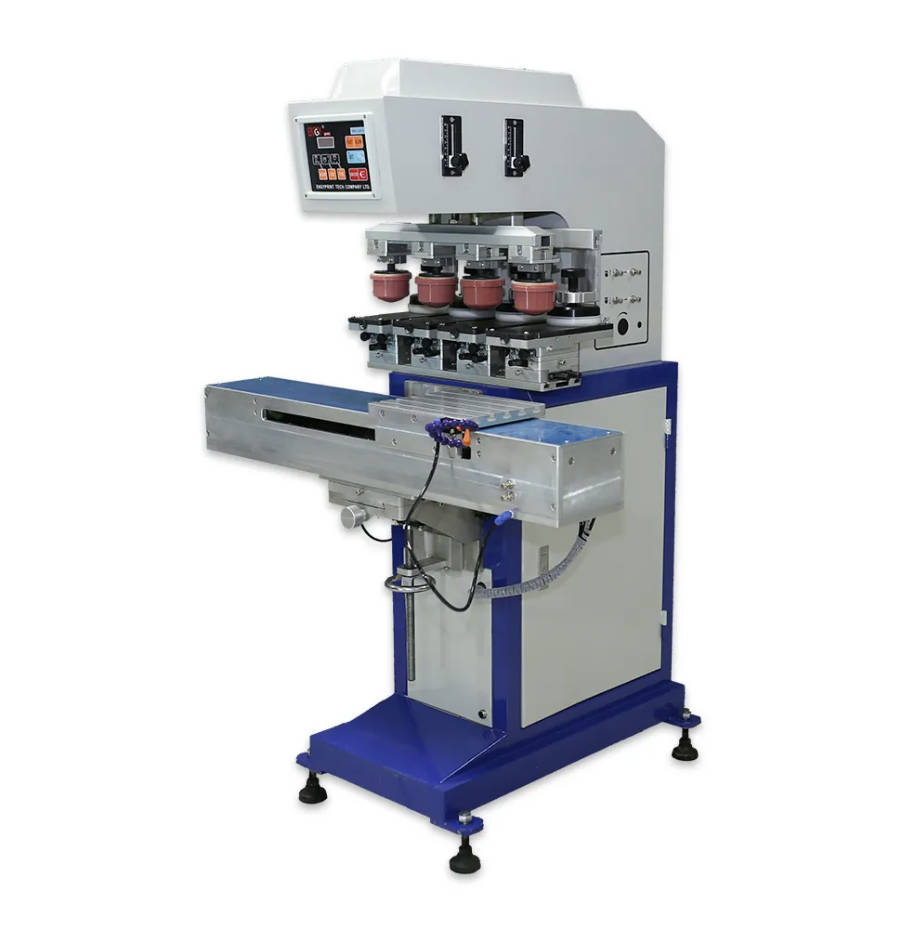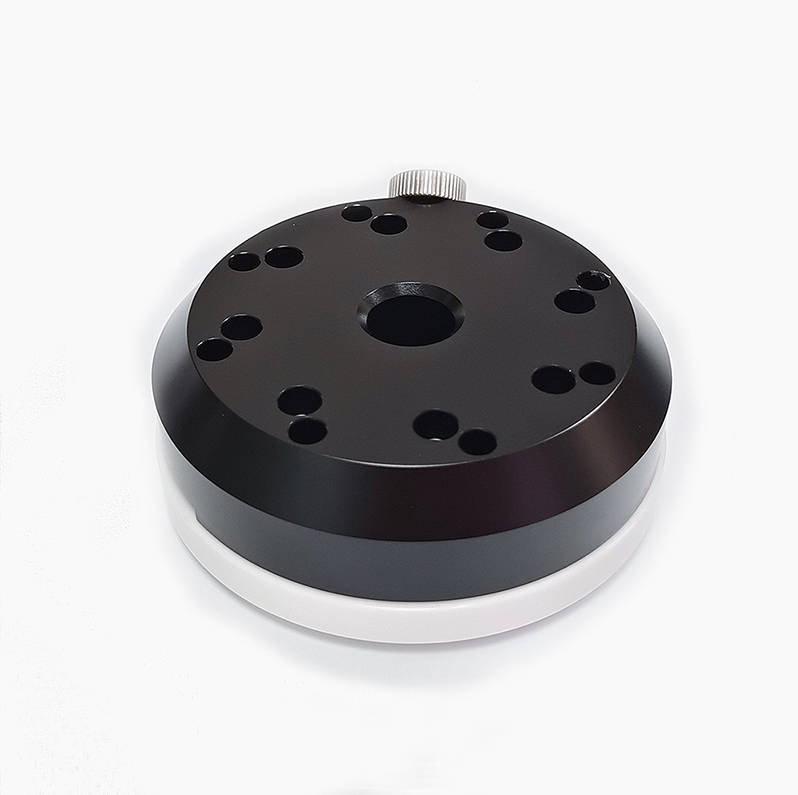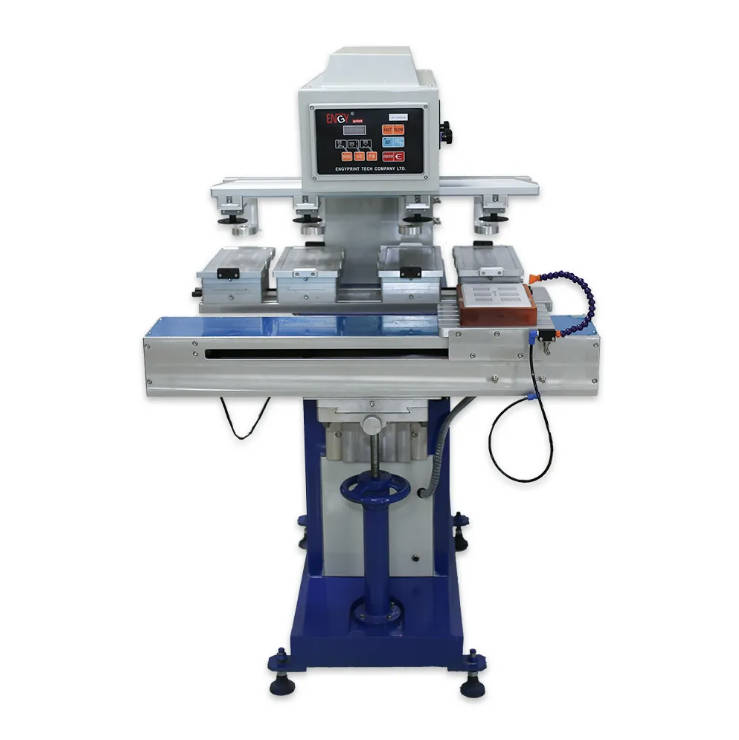Introduction to Pad Printing Technology
Pad printing is a process that transfers a 2D image onto a 3D object using a silicone pad. This versatile printing method is widely used across industries due to its ability to apply high-quality images on irregular or curved surfaces made from materials such as plastic, metal, glass, and ceramics. The process involves several key steps:
- Image Preparation: The desired image is etched onto a flat plate, known as a cliché.
- Ink Application: Ink is applied to the cliché, filling the etched areas.
- Pad Transfer: A flexible silicone pad picks up the ink from the cliché.
- Printing: The pad presses onto the object, transferring the ink to create a precise, durable print.
This method’s flexibility makes pad printing equipment essential for industries requiring detailed and durable markings on complex shapes. Its precision ensures that even the smallest details are accurately reproduced, while the durability of the prints allows them to withstand wear, environmental factors, and specific industry conditions. Additionally, pad printing is cost-effective for both small-scale custom jobs and large-scale production, making it a go-to solution for manufacturers.

Top 5 Industries That Rely on Pad Printing
1. Medical Device Industry
Essential for precise, regulatory-compliant labeling on small, curved surfaces. The medical device industry relies on high-precision pad printing machines to apply critical markings on devices such as syringes, surgical tools, catheters, and implantable devices. These markings, which include identification codes, usage instructions, and unique device identifiers (UDIs), must comply with stringent regulations, such as those outlined in the FDA’s 21 CFR Part 801 (FDA Device Labeling).
Key Requirements:
- Biocompatible Inks: Inks must be safe for medical use, non-toxic, and capable of withstanding sterilization processes without degrading.
- High Accuracy: Printing on small or intricate components demands exceptional precision to ensure legibility and compliance with regulatory standards.
Medical device manufacturers often use industrial pad printing machines to achieve the accuracy and reliability needed for high-stakes applications, ensuring patient safety and regulatory adherence.
2. Automotive Industry
Perfect for printing on irregular surfaces like dashboards and buttons. The automotive industry depends on automatic pad printing machines to apply durable markings on components such as gear knobs, steering wheel logos, dashboard icons, and sensors. These parts often feature complex shapes and are made from diverse materials, including plastics and metals, requiring a printing method that can adapt to varied surfaces.
Key Requirements:
- Durability: Prints must resist wear, heat, and exposure to chemicals like oils and fuels, ensuring longevity in harsh automotive environments.
- Material Compatibility: The ability to print on a wide range of materials, from soft plastics to hard metals, is critical.
High-speed pad printing machines are commonly employed in automotive manufacturing to keep up with high-volume production lines, ensuring efficiency without compromising quality.
3. Electronics Industry
Enables detailed printing on compact, intricate electronic components. The electronics sector uses multi-color pad printing machines to apply precise, detailed markings on items like smartphone buttons, remote controls, keyboards, and connectors. As electronic devices become smaller and more complex, pad printing’s ability to deliver sharp, high-resolution prints on tiny surfaces is invaluable.
Key Requirements:
- Precision: High accuracy is essential for small-scale prints, ensuring clarity for branding and functional markings.
- Specialized Inks: Depending on the application, inks may need to be conductive or resistant to specific environmental factors.
The use of industrial pad printing machines in electronics ensures that intricate, multi-colored designs are applied consistently, enhancing both functionality and aesthetics.
4. Toy Industry
Cost-effective for mass-producing colorful designs on toys. Pad printing is widely used in the toy industry to create vibrant, detailed prints on products like action figures, toy cars, and educational toys. These prints must be safe for children, as toys are often handled or even mouthed by young users.
Key Requirements:
- Non-Toxic Inks: Inks must comply with safety standards such as EN 71-3:2019 (EN 71-3 Standard) and ASTM F963 (ASTM F963 Standard), which limit the migration of harmful elements.
- Flexibility: The ability to print on various shapes and materials, from soft plastics to rigid components, is essential.
Toy manufacturers often rely on industrial pad printing machines to produce large quantities of toys with safe, vibrant designs that appeal to children and meet regulatory requirements.
5. Promotional Products Industry
Ideal for customizing branded items with logos or messages. The promotional products industry uses pad printing to apply logos, slogans, and designs on items like pens, keychains, mugs, and USB drives. The versatility and efficiency of high-speed pad printing machines make them ideal for handling large orders quickly.
Key Requirements:
- Fast Production: Machines must support high-volume printing to meet tight deadlines for promotional campaigns.
- Versatility: The ability to print on diverse products and materials ensures flexibility for varied client needs.
Automatic pad printing machines are particularly popular in this sector, enabling rapid customization of promotional items to meet marketing demands.
Benefits of Pad Printing Technology
Pad printing offers several advantages that make it a preferred choice across industries:
- Versatility: Pad printing equipment can print on nearly any surface or shape, from curved to flat, and on materials ranging from plastic to metal.
- Precision: It delivers sharp, detailed results, even on small or complex items, ensuring high-quality outputs.
- Durability: Prints are resistant to wear, chemicals, and environmental factors, making them suitable for demanding applications.
- Cost-Effectiveness: The technology is efficient for both small custom runs and large-scale production, offering flexibility for manufacturers.
These benefits make pad printing a reliable solution for industries with diverse printing needs.
Choosing the Right Pad Printing Machine
Selecting the appropriate pad printing machine depends on your production requirements, including volume, material types, and print complexity. Here’s a breakdown of the options:
Machine Types
- Manual Pad Printing Machines: Affordable and ideal for small or custom jobs where precision is prioritized over speed.
- Semi-Automatic Pad Printing Machines: Offer a balance of speed and cost, suitable for medium-sized production runs.
- Automatic Pad Printing Machines: Designed for high-volume manufacturing, these machines provide high-speed performance for large-scale operations.
Key Features to Consider
- Print Quality: Look for machines with adjustable settings to fine-tune print accuracy and consistency.
- Speed: Evaluate the prints-per-hour capacity to match your production demands.
- Versatility: Ensure the machine can handle the materials and shapes specific to your industry.
Maintenance Tips
- Regular Cleaning: Clean pads and plates regularly to maintain print quality and prevent defects.
- Pad Replacement: Replace worn pads promptly to ensure consistent results.
- Supplier Support: Partner with a reliable supplier for spare parts and technical support to minimize downtime.
Comparison Table
| Machine Type | Best For | Speed | Cost |
| Manual | Small or custom jobs | Low | Low |
| Semi-Automatic | Medium production runs | Medium | Medium |
| Automatic | Large-scale manufacturing | High | High |
This table helps users compare pad printing equipment options to find the best fit for their needs.
Conclusion
Pad printing technology is a cornerstone for industries requiring precise, durable, and cost-effective printing solutions. From medical devices needing regulatory-compliant markings to promotional products requiring rapid customization, pad printing machines meet diverse demands. Whether you need a manual pad printing machine for small-scale projects, a multi-color pad printing machine for intricate designs, or a high-speed pad printing machine for large orders, understanding your production needs is key. Consulting with experts and suppliers can help you select the right industrial pad printing machine to optimize your manufacturing process, ensuring efficiency and quality.





